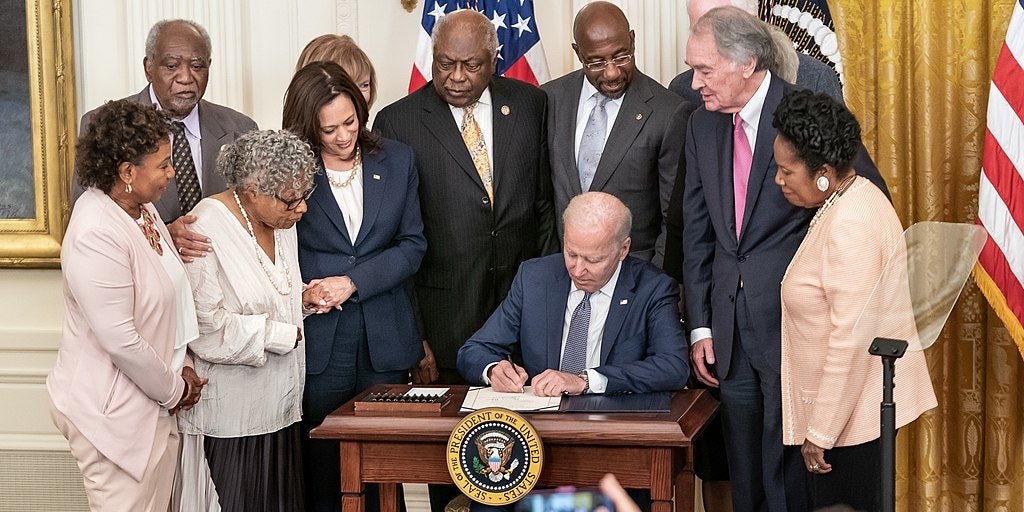- Author:
- Mary Rogelstad
- Published:
- June 16, 2022
- Favorites:
- Tagged In:
- Community Service
Community activist Opal Lee was 12-years-old when a large group of white rioters burned down her family’s home in Texas in 1939. The date the attack occurred would stick with her – June 19. It would be one catalyst for her decades-long mission to make Juneteenth a national holiday in the United States.
This finally happened in 2021 when President Joe Biden signed a bill making June 19 a federal holiday. The person who received the first of several pens he used during the signing was Opal Lee, who was then 94-years-old.

President Joe Biden talks with Opal Lee during the Juneteenth National Independence Day Act Bill Signing, Thursday, June 17, 2021, in the East Room of the White House. (Official White House Photo by Lawrence Jackson)
Juneteenth celebrates the emancipation of those who had been enslaved in the country. It commemorates the day in 1865 when word that slavery had been abolished finally reached Galveston, Texas. It took more than two years for the news to spread to this region.
It’s not entirely known why it took so long. Certainly one factor was the lack of Union soldiers in Texas to enforce the Emancipation Proclamation. Opal Lee has promoted leading 2.5 km walks to mark that extended time period.
Her efforts are among the better known ones that have promoted Juneteenth. Over the decades, celebrations of June 19th have varied from large to barely being noticeable. Much of that variance has depended on history.
Juneteenth Celebrations & Lessons
In the early days, Juneteenth was little recognized outside of African American communities. They celebrated the day with barbecues, speeches, and prayer services. Marking the day became more difficult when the Great Depression seized the nation.
When workers had to move to the cities for jobs, employers were unlikely to grant a day off on June 19. Details about Juneteenth were also not taught in schools.
After many years of virtual silence, the Civil Rights Movement proved one important point – that awareness is key. Juneteenth showcases how it’s much easier for injustices to occur in the shadows.
Civil Rights leaders were able to reignite awareness about the struggles of their ancestors and connect it to modern times. During the Poor People’s March to Washington D.C. Rev. Ralph Abernathy inspired attendees to return home and organize Juneteenth celebrations.
Those festivities re-focused attention on ongoing efforts to stomp out hidden injustices. Juneteenth clearly shows that for two and half years enslaved people in Texas did not know they were legally free – that signing a bill was not enough. The celebration reminds the international community of the difficulties of ensuring freedom.
Modern Day Slavery Around the World
Today the worldwide community is still battling against slavery. The International Labor Organization (ILO) estimates that more than 40 million people worldwide are victims of modern slavery. This includes anyone who cannot refuse work or leave a situation because of threats, violence, or other abuses of power. Among the victims are those who experience forced labor, debt bondage, forced marriage, and human trafficking.
On top of this, it’s estimate that almost one in ten children around the world are subjected to child labor, totaling more than 150 million children. Poverty is the leading reason for this, but in unstable countries children are also pulled into armed conflict and illegal activities, along with potentially being trafficked.
The United Nations has recognized these problems and has created several days to mark the struggles of the past and present. On March 25, the international community remember victims of slavery. On August 23, the focus turns to the abolition of the trans-Atlantic slave trade. This date marks the day in 1791 when enslaved people in present day Haiti revolted against slavery, setting events in motion that would eventually end the trans-Atlantic slave trade.
Finally, on December 2 the United Nations calls for the abolition of current slave trade practices.
What You Can Do
While recognizing these days, it’s helpful to keep in mind small steps everyone can take to fight against modern day slavery. This includes:
- Raising awareness about past and present injustices
- Buying Fair Trade items – These have been created in an ethical manner, including fair labor conditions. Examples of well-known companies that sell these items include Everlane, Honest Tea, Ben & Jerry’s, and Nisolo
- Buying items from local artisans and merchants when traveling
- Supporting nonprofits that fight trafficking and support survivors. This includes organizations like the Safe House Project in the United States.
- Promoting education about Juneteenth and similar commemorations at schools, along with information about modern day injustices across the globe
You also can follow the advice of Opal Lee who recommended celebrating freedom from June 19 to July 4. A few traditions primarily associated with the Fourth of July also are relevant for Juneteenth. For example, there are patriotic songs generally associated with freedom. When the Emancipation Proclamation was issued, formerly enslaved people broke out in song, singing America (My Country, ’Tis of Thee).
That said, there are other songs that primarily are associated with the deep impact of slavery. One of the best known is one that was sung when enslaved people escaped called Many Thousand Go. As its lyrics say:
“No more auction block for me – no more – no more. No more auction block for me. Many thousand go.”
View how Rustic Pathways students make a global impact that helps small communities overcome injustices and thrive.
Mary Rogelstad
Lead Editor
Mary is the Lead Editor at Rustic Pathways. She has been a writer and editor for nearly 20 years. Prior to covering student travel, Mary created content for the music education company J.W. Pepper & Son. She also was a writer and producer at CNN International and a communications director for a social service agency and a K-12 private school.
